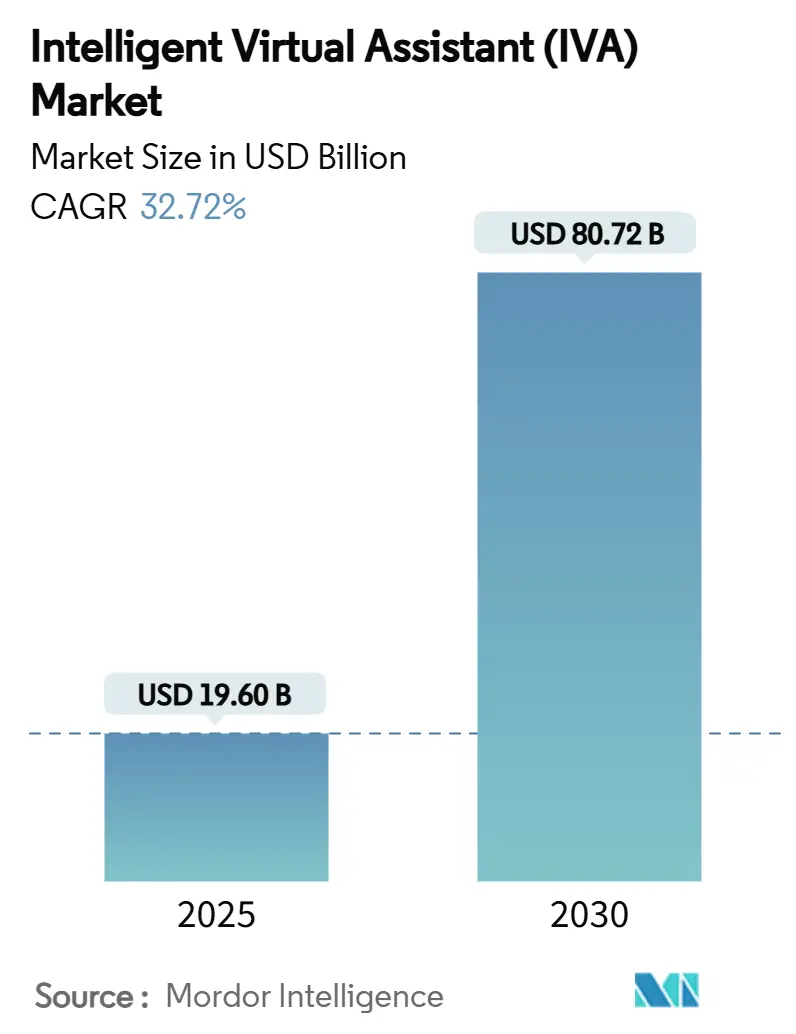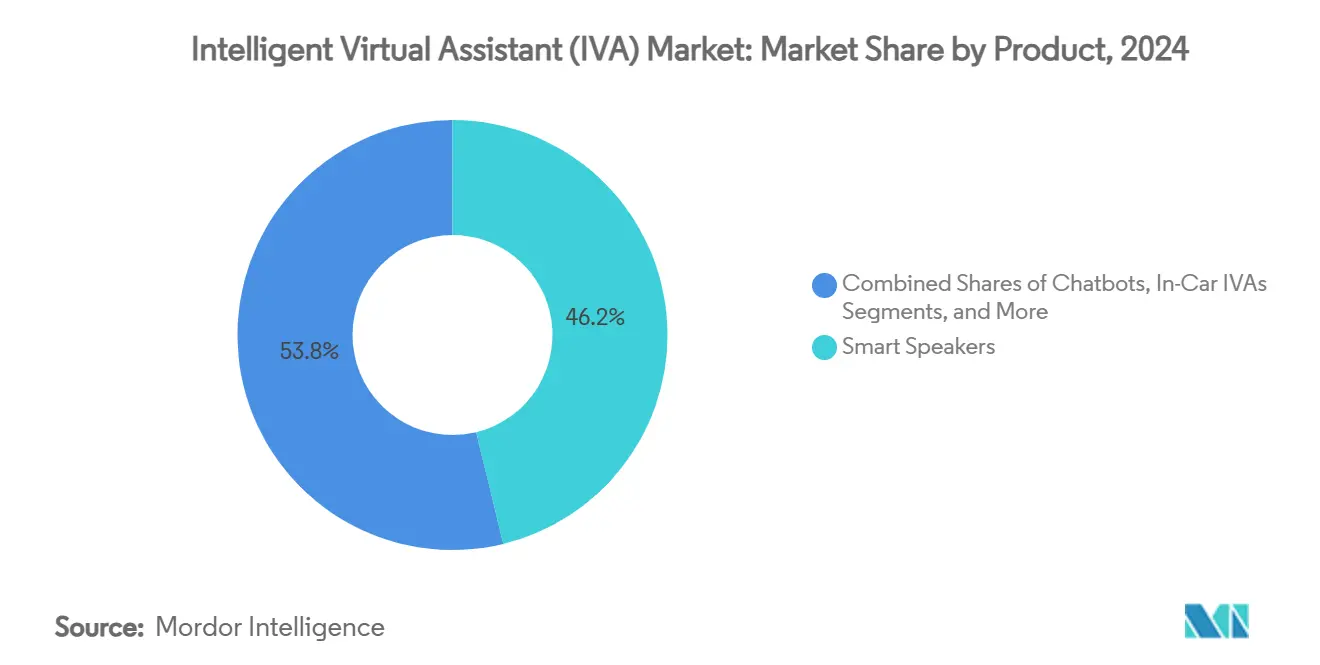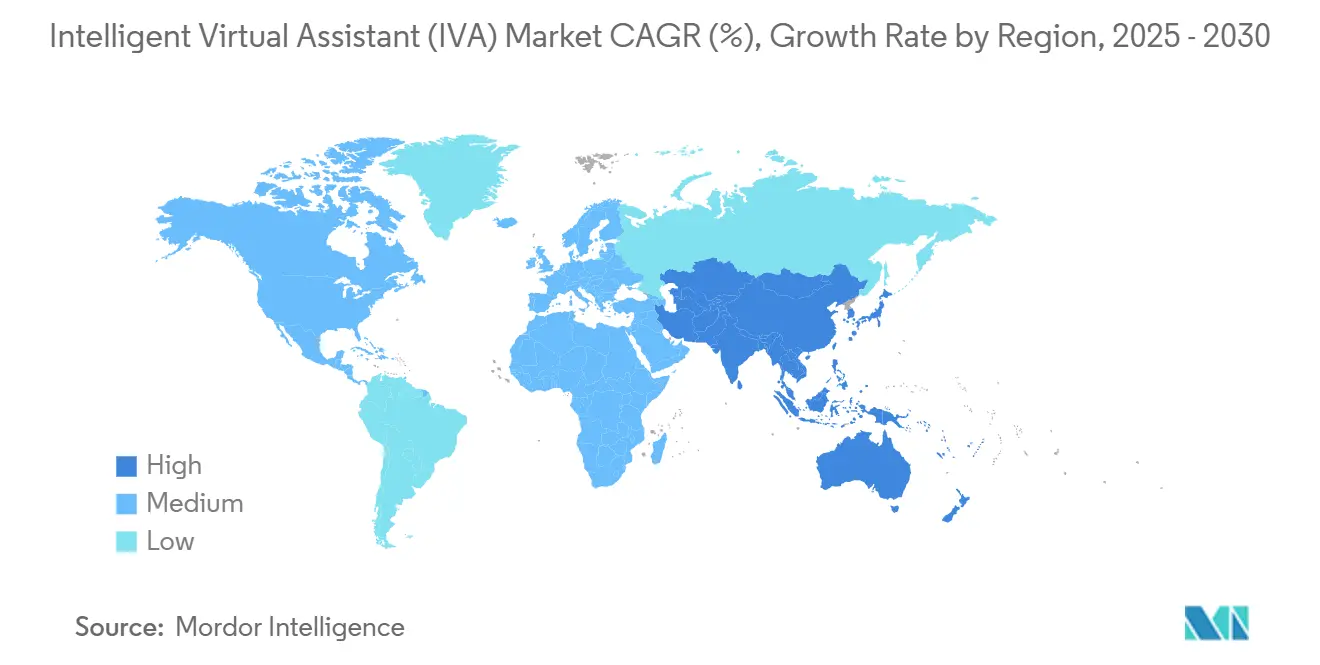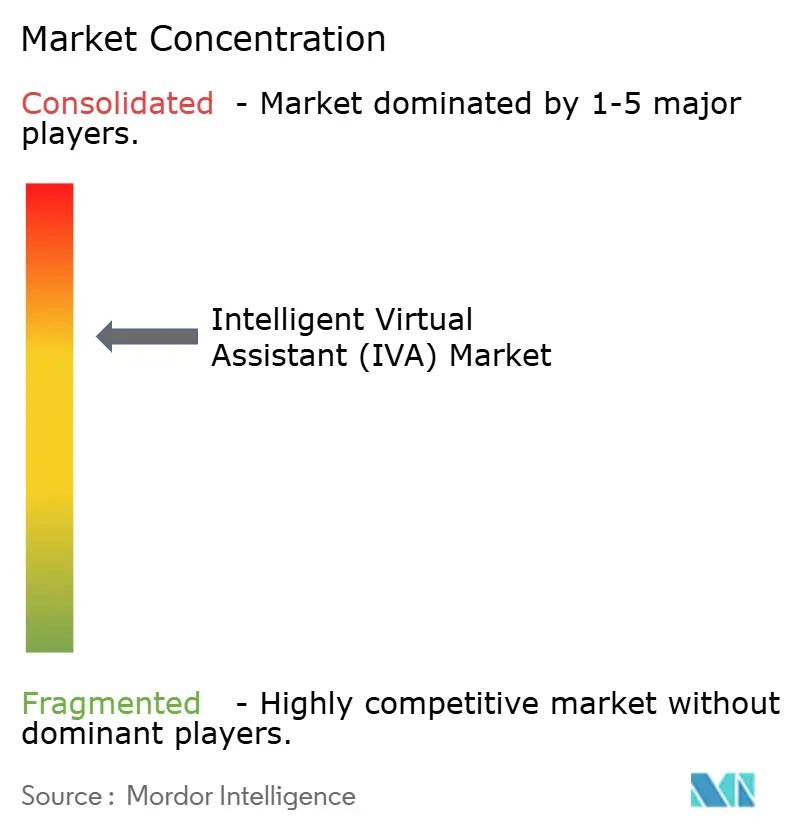Intelligent Virtual Assistant (IVA) Market Size and Share

Intelligent Virtual Assistant (IVA) Market Analysis by Mordor Intelligence
The intelligent virtual assistant market is valued at USD 19.60 billion in 2025 and is forecast to grow to USD 80.72 billion by 2030, registering a 32.72% CAGR. Multilingual large-language models, on-device inference enabled by specialized AI chips that retail for about USD 40,000 per unit, and corporate pressure to curb expanding cloud costs are the primary forces behind this rapid expansion. Enterprises continue to invest because generative AI deployments are demonstrating clear savings; a major travel company, for example, reports USD 10 million in annual cost reductions after introducing an IVA-led self-service channel. Edge and on-premise options that avoid recurring hyperscale fees are moving up the priority list, even though cloud remains dominant. The momentum is equally visible in consumer hardware, as the popularity of smart speakers and in-car assistants reshapes expectations for always-on conversational services.
Key Report Takeaways
- By product, smart speakers led with 46.2% revenue share in 2024, while in-car IVAs are advancing at a 33.1% CAGR through 2030.
- By deployment mode, cloud held 68.0% of the intelligent virtual assistant market share in 2024; on-premise and edge are expanding at 34.5% CAGR through 2030.
- By user-interface technology, voice-based systems commanded 57.5% share in 2024; multimodal voice-visual solutions are set to grow at 33.5% CAGR to 2030.
- By end-user, retail and eCommerce captured 24.3% of the intelligent virtual assistant market size in 2024, whereas healthcare is projected to rise at 33.23% CAGR between 2025-2030.
- By geography, North America accounted for 37.0% market share in 2024; Asia Pacific is expected to post the fastest 34.8% CAGR through 2030.
Global Intelligent Virtual Assistant (IVA) Market Trends and Insights
Drivers Impact Analysis
| Driver | (~) (%) Impact on CAGR Forecast | Geographic Relevance | Impact Timeline |
|---|---|---|---|
| Rising adoption of omnichannel customer-service chatbots | +8.5% | Global, strongest in North America and Europe | Short term (≤ 2 years) |
| Proliferation of smart speakers and IoT voice end-points | +7.2% | North America and Asia Pacific, spreading to Europe | Medium term (2–4 years) |
| Breakthroughs in multilingual large-language-model NLP | +6.8% | Global, notable in Asia Pacific and Europe | Medium term (2–4 years) |
| Contact-center cost-containment pressure | +5.1% | Worldwide, highest in North America and Europe | Short term (≤ 2 years) |
| Emotion-aware IVA uptake in elder-care and digital therapeutics | +3.4% | North America and Europe, reaching Asia Pacific | Long term (≥ 4 years) |
| Accessibility mandates for public-sector digital services | +2.8% | Europe and North America, global spillover | Medium term (2–4 years) |
| Source: Mordor Intelligence | |||
Rising Adoption of Omnichannel Customer-Service Chatbots
Global banks expect to invest USD 9.4 billion in chatbot technology by 2025, a sign of how strongly cost-containment needs align with 24/7 service expectations.[1]IBM Corp., “Camping World boosts engagement 40% with virtual assistant,” ibm.com Autonomous resolution rates of 80-90% are increasingly common, and productivity gains reaching 40% have been logged by early banking adopters. Retailers cite engagement lifts of 40% when text, voice, and visual channels are fused into a single flow, creating smooth hand-offs to human agents when context demands. Memory-based personalization now preserves conversation history across devices, allowing customers to resume interactions without repetition. The result is higher customer-satisfaction scores alongside measurable savings in contact-center workloads.
Proliferation of Smart Speakers and IoT Voice End-Points
Automotive OEMs tap voice platforms from Cerence, Microsoft, and NVIDIA to add ChatGPT-style services directly to infotainment stacks.[2]Cerence Inc., “Volkswagen rolls out Chat GPT-powered assistant,” cerence.comVolkswagen’s European models already ship with a cloud-updated assistant that supports five languages. Beyond cars, appliance makers and wearable brands embed local speech recognition to protect privacy and cut latency. Driver surveys find that 77% would choose in-vehicle voice control when advanced features are available. As vendors port the same core models to embedded silicon, the intelligent virtual assistant market gains new daily-use entry points inside homes, cars, and industrial settings.
Breakthroughs in Multilingual Large-Language-Model NLP
Open-source models such as Babel cover languages spoken by more than 90% of the global population, lowering barriers for enterprises that once needed separate models for every geography. Healthcare providers, for instance, now deploy the same virtual nurse across 25 languages without retraining. Retrieval-augmented approaches help lift accuracy for low-resource dialects, protecting cultural nuances and enabling IVA rollout in Southeast Asia, Africa, and Latin America. As sentiment and intent detection improve, assistants can tailor tone, etiquette, and even humor to local norms, strengthening user trust.
Contact-Center Cost-Containment Pressure
A leading U.S. travel company shifted containment rates from 10% to 50% in one month, yielding USD 10 million in annual savings. AXA reduced average handle time by more than 20% after deploying a hybrid IVR-IVA workflow. Wealth-management firms record USD 6.7 million savings by automating 400 frequent inquiries while boosting customer-experience scores. Predictive routing and proactive prompts are next on the roadmap, aiming to deflect simple tickets before they reach agents. CFOs therefore see IVAs not only as a CX tool but also as a direct lever on service-line margins.
Restraints Impact Analysis
| Restraint | (~) (%) Impact on CAGR Forecast | Geographic Relevance | Impact Timeline |
|---|---|---|---|
| Persistent privacy and data-security concerns | -4.2% | Global, heightened in Europe and North America | Medium term (2–4 years) |
| Customer preference for human agents in complex queries | -3.8% | Worldwide, cultural variance in acceptance | Short term (≤ 2 years) |
| Regulatory scrutiny on AI explainability and dark-patterns | -2.9% | Europe in lead, North America and Asia Pacific following | Long term (≥ 4 years) |
| Hallucination-driven brand-reputation risk | -2.1% | Global, acute in regulated industries | Medium term (2–4 years) |
| Source: Mordor Intelligence | |||
Persistent Privacy and Data-Security Concerns
The EU AI Act’s privacy-preserving clauses force suppliers to demonstrate data-minimization and encryption by design.[3]European Union, “Regulation on Artificial Intelligence,” eur-lex.europa.eu In healthcare, U.S. ONC rules demand transparent decision logs for predictive algorithms. Financial institutions add traceable pipelines and differential-privacy techniques, but those investments raise project costs and lengthen deployment cycles. Many chiefs therefore favor on-premise stacks that keep all customer utterances in situ, reporting cost reductions of up to 80% versus equivalent cloud bills while satisfying sovereignty rules.
Regulatory Scrutiny on AI Explainability and Dark-Patterns
High-risk classifications under the EU AI Act require technical documentation that captures model logic, training data lineage, and mitigation procedures, a departure from earlier black-box approaches. The U.S. NIST AI Risk Management Framework, now referenced in several state laws, prescribes independent auditing of algorithmic bias. These obligations slow product cycles and push vendors toward inherently interpretable architectures. Firms exporting to multiple jurisdictions must navigate overlapping rulesets, adding legal review overhead that can delay intelligent virtual assistant market launches by quarters.
Segment Analysis
By Product: Smart Speakers Lead Despite In-Car Surge
Smart speakers generated 46.2% of 2024 revenue, underscoring the sizeable installed base that continues to expand through bundling with music or video services. Although growth moderates in mature markets, vendors are upselling premium tiers that feature high-fidelity microphones and local language-model inference to reduce cloud calls. At the same time, in-car assistants are on track to post 33.1% CAGR through 2030, the fastest among hardware categories. Automakers such as Volkswagen and Renault use white-label offerings from Cerence to deliver conversational navigation, climate control, and e-commerce services on the road.
Wearable and embedded IVA modules for AR headsets and industrial scanners supply a fresh entry path, enabling voice commands that free workers’ hands in logistics and field maintenance. These devices often combine voice with gaze, gesture, or haptic feedback, elevating user ergonomics. The intelligent virtual assistant market now spans a continuum from stationary speakers to fully mobile endpoints, and suppliers are tailoring neural-network footprints to the computational limits of each form factor.

Note: Segment shares of all individual segments available upon report purchase
By Deployment Mode: Cloud Dominance Meets Edge Computing Surge
Cloud deployment still accounts for 68.0% of current spend because of easy scaling, model updates, and integration with enterprise software. Yet, cost predictability and data-localization laws are driving a decisive turn to on-prem and edge deployments that are growing 34.5% annually. Enterprises deploying generative AI chips on site report overall inference expenses as low as one-fifth of comparable cloud bills.[4]Broadcom Inc., “On-prem AI delivers lower TCO for enterprise deployments,” broadcom.com The intelligent virtual assistant market size for on-prem projects is forecast to expand sharply as regulated verticals move sensitive voice logs inside the firewall.
Edge-native IVAs support real-time workloads in automotive, aerospace, and healthcare devices where sub-100-millisecond latency is mandatory. Suppliers are now shipping neural-processing-unit cores that host quantized LLMs with less than 8 GB of memory. This specialization lowers energy draw while keeping conversational context intact, a key requirement for uninterrupted driving or surgical assistance scenarios.
By User Interface Technology: Voice Leadership with Multimodal Acceleration
Voice remains the primary gateway, comprising 57.5% share in 2024 thanks to decades of ASR and TTS refinement. However, multimodal systems that merge speech with visual or gestural cues are growing at 33.5% CAGR. Automotive avatars that offer human-like eye contact and facial expressions demonstrate how visual feedback raises perceived empathy. In mixed-reality headsets, integrating gaze tracking with speech resolves pronoun ambiguity, improving task completion times by 14% in pilot studies.
Text interfaces continue to serve back-office use cases where searchable transcripts and audit trails are obligatory, notably in banking and insurance. Cross-channel orchestration platforms now synchronize voice, chat, and video conversations using a single context store, ensuring that customer identity, intent, and preferences flow across modalities without data loss.

By End-User: Retail Maturity Contrasts Healthcare Acceleration
Retail and eCommerce held 24.3% of spending in 2024 as merchants rout routine inquiries, delivery tracking, and return processing to chatbots. KPI dashboards confirm 40% faster customer-journey completion times when IVAs triage incoming queries before escalation to agents. Healthcare, though smaller today, is slated to grow at 33.23% CAGR, buoyed by digital-therapeutics adherence reminders, remote patient monitoring, and elder-care companionship services. Hospitals deploying virtual nurses have cut readmissions by 25% while raising patient-engagement metrics.
Financial services adoption also accelerates because voice biometrics short-circuit identity verification and comply with strong-authentication directives. Telecom operators lean on IVAs to manage peak call volumes, with 40% of CX leaders budgeting above-inflation increases for conversational AI to guard against churn rates. Travel brands adapt the technology into concierge-style helpers that manage itinerary changes through simple voice prompts.
Geography Analysis
North America holds 37.0% share on the strength of early enterprise investment, a deep venture capital pool, and a maturing vendor ecosystem. State-level laws in Utah, Colorado, and California emphasize transparency, while the federal NIST framework offers a common risk-management vocabulary. Healthcare IVAs must log explainability evidence to meet ONC standards, prompting providers to choose platforms that expose full decision traces. Canada’s accessibility mandate EN 301 549:2024 further cements demand for inclusive voice technologies that work for users with disabilities. The region’s R&D capability combined with a robust compliance culture maintains a lead in commercial deployments.
Asia Pacific is the fastest-expanding region at 34.8% CAGR. Government AI strategies, such as China’s national roadmap and Singapore’s SGD 1 billion allocation, underwrite talent development and pilot programs. Conversational AI adoption in India’s banking arena demonstrates how multilingual IVAs extend branch reach at lower cost. Japanese automakers push in-car assistants as brand differentiators, integrating edge AI chips to overcome patchy cellular coverage. Linguistic diversity remains a hurdle, but recent multilingual LLM breakthroughs shrink development timelines and open the intelligent virtual assistant market to mid-tier enterprises.
Europe occupies a pivotal role, balancing innovation with stringent governance. The EU AI Act imposes harmonized rules that cover classification, documentation, and human oversight, nudging suppliers toward transparent model architectures. Automotive firms collaborate with AI specialists to comply with both functional safety norms and new explainability clauses. Accessibility guidance in EN 301 549 ensures inclusive design, while healthcare institutions adopt IVA tools only after rigorous bias audits. Vendors that can certify privacy and fairness gain preferred status in public-sector tenders, shaping competitive dynamics across the continent.

Competitive Landscape
Large platform vendors and niche specialists coexist in a moderately consolidated arena. Top cloud providers embed conversational AI into broader SaaS portfolios, while automotive OEMs forge multi-year alliances with voice-tech firms to accelerate time to market. Cerence’s cooperative projects with Microsoft and NVIDIA typify symbiotic deals where domain knowledge meets GPU optimization. Volkswagen’s rapid ChatGPT rollout illustrates OEM preference for turnkey solutions rather than ground-up development.
Meanwhile, disruptors target cost and privacy gaps with on-device models. Start-ups designing neuromorphic chips promise inference at single-watt power budgets, a lure for wearables and IoT devices where battery life is king. Patent filings on personalized multimodal agents rise sharply; Microsoft’s latest submission outlines dynamic response synthesis based on stored user-interest vectors. Suppliers now compete on measurable ROI, hardened security features, and certified compliance toolkits, not merely conversational flair.
Healthcare, elder-care, and accessibility niches present white-space openings protected by regulatory barriers. Companies capable of furnishing audit-ready logs and meeting medical-device standards command premium pricing. Taken together, the intelligent virtual assistant market shows healthy rivalry across tiers while leaving room for specialized entrants to flourish.
Intelligent Virtual Assistant (IVA) Industry Leaders
-
IBM Corporation
-
Inbenta Technologies
-
Apple Inc.
-
Amazon.com Inc.
-
Microsoft Corp.
- *Disclaimer: Major Players sorted in no particular order

Recent Industry Developments
- January 2025: Cerence broadened its partnership with NVIDIA to optimize the CaLLM family of automotive language models using TensorRT-LLM for lower latency and higher accuracy.
- January 2025: HARMAN introduced Luna, an emotionally aware in-car avatar developed with Cerence, and announced joint ADAS projects with HL Klemove.
- December 2024: VCI Global invested in Marvis to advance AI digital-clone technology at a USD 30 million valuation cap.
- October 2024: Renault integrated Cerence Chat Pro into the Reno companion debuting in the Renault 5 E-Tech EV.
Global Intelligent Virtual Assistant (IVA) Market Report Scope
An intelligent virtual assistant is a computer system that uses artificial intelligence (AI) to act like a person and do tasks like customer service.This technology uses parts of IVR and other modern artificial intelligence projects to give users full-fledged virtual identities that can talk with them.
The Intelligent Virtual Assistant (IVA) Market is segmented by Product (Chatbot, Smart Speaker), User Interface (Text-to-Text, Text-to-Speech, Automatic Speech Recognition), End User (For Chatbots (Retail, Healthcare, BFSI, Telecom, Travel and Hospitality), For Smart Speaker (Personal and Commercial)), and Geography.
The market sizes and forecasts are provided in terms of value (USD) for all the above segments.
| Chatbots |
| Smart Speakers |
| In-Car IVAs |
| Wearable / Embedded Devices |
| Cloud |
| On-premise / Edge |
| Text-based (Text-to-Text) |
| Voice-based (ASR + TTS) |
| Multimodal (Voice + Visual) |
| Retail and eCommerce |
| BFSI |
| Healthcare |
| Telecom and IT |
| Travel and Hospitality |
| Other Industries |
| North America | United States |
| Canada | |
| Mexico | |
| South America | Brazil |
| Argentina | |
| Rest of South America | |
| Europe | Germany |
| United Kingdom | |
| France | |
| Spain | |
| Netherlands | |
| Rest of Europe | |
| Asia-Pacific | China |
| Japan | |
| India | |
| South Korea | |
| Rest of Asia-Pacific | |
| Middle East and Africa | United Arab Emirates |
| Saudi Arabia | |
| South Africa | |
| Rest of Middle East and Africa |
| By Product (Value) | Chatbots | |
| Smart Speakers | ||
| In-Car IVAs | ||
| Wearable / Embedded Devices | ||
| By Deployment Mode (Value) | Cloud | |
| On-premise / Edge | ||
| By User Interface Technology (Value) | Text-based (Text-to-Text) | |
| Voice-based (ASR + TTS) | ||
| Multimodal (Voice + Visual) | ||
| By End-User | Retail and eCommerce | |
| BFSI | ||
| Healthcare | ||
| Telecom and IT | ||
| Travel and Hospitality | ||
| Other Industries | ||
| By Geography (Value) | North America | United States |
| Canada | ||
| Mexico | ||
| South America | Brazil | |
| Argentina | ||
| Rest of South America | ||
| Europe | Germany | |
| United Kingdom | ||
| France | ||
| Spain | ||
| Netherlands | ||
| Rest of Europe | ||
| Asia-Pacific | China | |
| Japan | ||
| India | ||
| South Korea | ||
| Rest of Asia-Pacific | ||
| Middle East and Africa | United Arab Emirates | |
| Saudi Arabia | ||
| South Africa | ||
| Rest of Middle East and Africa | ||
Key Questions Answered in the Report
What is the current value of the intelligent virtual assistant market?
The market stands at USD 19.60 billion in 2025 and is projected to hit USD 80.72 billion by 2030.
Which product type leads the intelligent virtual assistant market?
Smart speakers lead with 46.2% revenue share, although in-car assistants are growing fastest at 33.1% CAGR.
Why are enterprises moving IVA workloads on-premise?
On-prem deployments lower inference costs to as little as one-fifth of cloud expense and satisfy data-sovereignty rules.
Which industry vertical is expanding most rapidly?
Healthcare IVAs are forecast to grow at 33.23% CAGR through 2030, driven by remote-care and elder-care use cases.
Which region will add the most new IVA revenue by 2030?
Asia Pacific, supported by large-scale AI initiatives in China, India, and Southeast Asia, is projected to log the highest 34.8% CAGR.
How do privacy regulations affect IVA adoption?
Frameworks such as the EU AI Act and U.S. ONC transparency rules require auditable data handling and explainable outputs, prompting many firms to favor on-prem or edge deployments for greater control.
Page last updated on:



